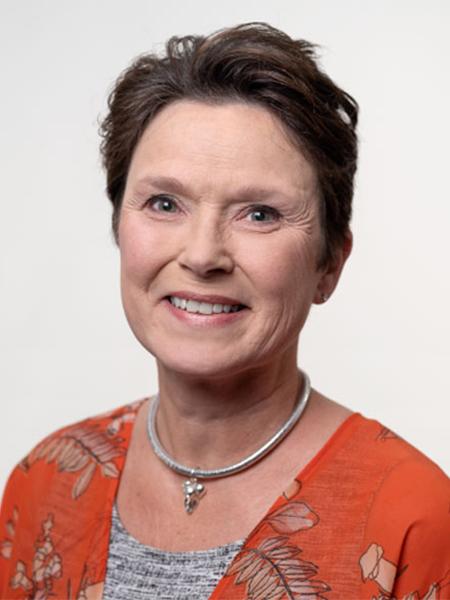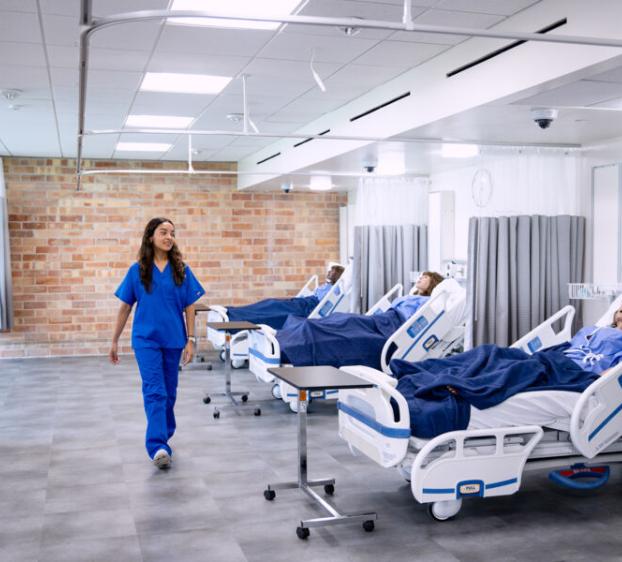Nursing Program Meets Workforce Need

The founding director of the St. Edward’s nursing program, Donna Beuk, is a critical care nurse who earned a doctorate of Education in Instructional Leadership with a specialization in Nurse Education. She explains how St. Edward’s nursing program will train nurses to bring a compassionate, justice-oriented perspective to this in-demand profession.
Why is There a Shortage of Nurses in the U.S.?
The shortage has existed for decades but has gotten more acute because of the number of nurses and nursing educators who are reaching retirement. If we don’t have enough faculty, we can’t take on as many students. The pandemic also brought economic changes and, for some people, burnout that further eroded our workforce.
Meanwhile, the need for nurses continues to increase. Our country has an aging population, which requires more healthcare providers. Our healthcare system also needs more nurses to do patient care and health education in the community, to reduce the load on hospitals.
Where is The Need for Nurses Greatest in Central Texas?
Because of its rapidly growing population, Texas is the state with the second-most critical need for nurses. In the Greater Austin area, specifically, there are four hospitals that have earned Magnet status, representing excellence in nursing care, by the American Association of Colleges of Nursing. To retain their Magnet designation, hospitals are required to have a large percentage of their nurses who hold a Bachelor of Science in Nursing. St. Edward’s graduates will be well positioned for these jobs.
BSN-prepared nurses are needed in settings beyond hospitals. A tremendous body of research has shown that care from a BSN-prepared nurse results in more positive patient outcomes. The Central Texas area has a number of rural community health positions that can be filled by BSN-trained nurses, whose education has included the clinical reasoning and critical thinking skills needed for these jobs.

We will train nurses who will exhibit supportive leadership, advocate for their patients, themselves, and other nursing colleagues by making their voices heard.
Are There Other Ways the St. Edward’s Nursing Program Can Help Stem the Shortage, Beyond Graduating More New Nurses?
Yes, it can help shift the culture of nursing to be more supportive. One reason we’ve lost nurses from the profession is incivility. In nursing programs, students are educated about evidence-based practice and the best standard of care. But sometimes, when they enter the workforce, they encounter suboptimal practices referred to as “the real world of nursing.” Senior nurses have occasionally used a “trial by fire” approach to training new graduates, putting them in overwhelming situations to test them. This takes risks with patient care and has led young nurses to burn out and leave the profession.
We will train nurses who will exhibit supportive leadership, advocate for their patients, themselves, and other nursing colleagues by making their voices heard.
What is the Role of the St. Edward’s Mission in Shaping a Nursing Program?
In 2021, the National Academy of Medicine published a report called The Future of Nursing 2020-2030: Charting a Path to Achieve Health Equity. This report emphasized how critical it is for our nurses to learn about social determinants of health, health disparities and health equity, so they understand the structural factors that influence their patients’ lives. These ideas about equity are central to the St. Edward’s mission.
Our mission also speaks about the dignity of the human person. Treating our patients and families with dignity means giving the person who has been living on the street the same quality of care as a person who holds political office. It means treating the individual with respect and caring for the whole person. It means following policies and maintaining professional boundaries, while being a strong advocate for the patients in your care. The St. Edward’s approach means our students will develop the ethical reasoning skills and compassionate hearts to make a difference.
The Future of Nursing 2020-2030: Chartering a Path to Achieve Health Equity provides a charge to diversity the nursing population. We are dedicated to providing educational opportunity for social mobility to a diverse student body. In doing what we do so well, we will provide a pathway towards diversifying the profession.
What Other Soft Skills or Perspectives are Important for Today’s Nurses?
Charting a Path to Achieve Health Equity highlights the importance of cultural understanding in nursing education. This is usually taught in upper-division nursing courses, but here at St. Edward’s, that cultural competency is integrated into all students’ education from the beginning.
The report also emphasizes the importance of diversifying the nursing profession. We are excited that St. Edward’s will educate a diverse population of future nurses who will contribute their talents to the profession. This program will change not only the lives of our students but also the lives of the communities where they work.
What Experiential Education Facilities Will the St. Edward’s Nursing Program Offer?
The type of simulation work students do will vary depending on their program, but experiential learning begins the first semester of the BSN program. We will have two high-fidelity simulation suites, where students will apply their skills in simulations with manikins. One will focus on adult healthcare, the other on women’s health, pediatrics and family health. We will have a lab that focuses on wellness promotion and therapeutic communication. Another lab will focus on clinical skills, with task trainers and low- and mid-fidelity simulators; it will look like a hospital ward. And we’ll have a briefing room, where students will learn what they’ll do that day and then come back afterward and talk about what they learned.
In addition to simulated learning experiences, students will engage in acute care and community-based settings. These experiential learning opportunities will afford students real world engagement with patients, families, and the community.
How Does Simulation Improve Nursing Education?
It allows nurses to practice their skills in situations that are very similar to what they’ll encounter in the workplace, but in an environment where they can learn from their mistakes instead of jeopardizing real people’s health. Simulation can involve small task trainers, like a simulated arm that students use to practice inserting an IV, or full-size manikins that mimic human bodily functions. It can involve actors who portray patients, so that nurses can practice communication. It also includes augmented reality.
Our students will participate in simulations and, just as important, they will reflect on their performance and journal about their experience afterward. What did they do well, and what can they do better in the future?

The St. Edward’s approach means our students will develop the ethical reasoning skills and compassionate hearts to make a difference.
How Will Students Benefit from Partnerships in the Austin Community?
When students complete their clinical hours and practicum off campus, they will take advantage of our partnerships with different hospital systems across the Greater Austin area and with community health providers. For their clinical hours they will choose among sites that focus on public health, hospice palliative care, veterans care, correctional nursing and occupational health nursing. It is not unusual for students to be hired at the site where they complete clinical hours.
Because St. Edward’s is located in Austin, our students have the opportunity to influence legislation at the Capitol that affects health policy and the profession of nursing. Students also can attend the quarterly meetings of the Texas Board of Nursing to stay current on this legislation and other developments that affect our field.

Explore Our Nursing Programs
St. Edward’s is proud to offer three exceptional programs that provide pathways and preparation for earning a Bachelor of Science in Nursing. The Registered Nurse to Bachelor of Science in Nursing (RN to BSN) program gives registered nurses several options for earning their BS in Nursing. Our Bachelor of Arts in Biology, Pre-Nursing Track and Bachelor of Science in Biology, Health Professions Track prepare traditional undergraduate students to transition into BS in Nursing and Accelerated BS in Nursing programs.
Learn more and apply for our RN to BSN, Pre-Nursing and Health Professions Programs.


